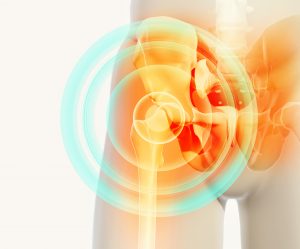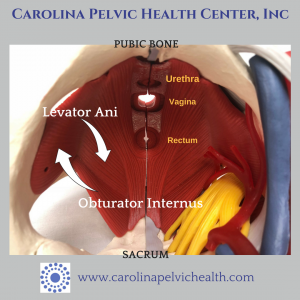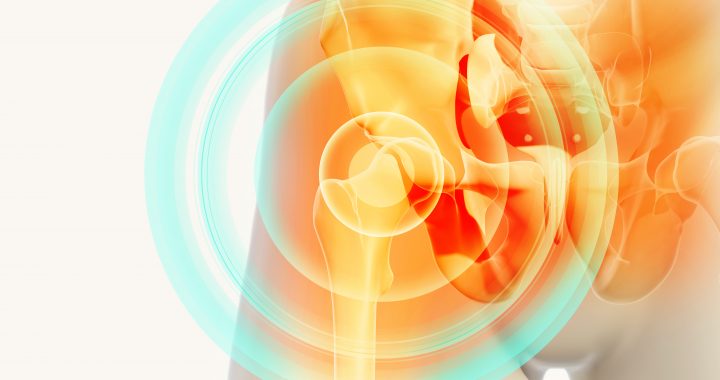 What is that deep, hard to reach pain in my pelvis? It might be coming from your hip.
What is that deep, hard to reach pain in my pelvis? It might be coming from your hip.
Hip pain and pelvic floor connection:
Did you know that your pelvic floor muscles are directly attached you your hip muscles? That’s right, the hip bone is connected to the pelvic bone and the pelvic floor muscles are connected to the one of your hip muscles: the obturator internus (OI)!
A big job for a small muscle:

The OI is one of six lateral rotators of your hip (perhaps you’ve heard of its most popular relative, the pirifomis). The role of the obturator internus (OI) muscle is to assist in rotation and stabilization of the leg on the pelvis. This provides stability while moving as well as a site of attachment for the pelvic floor muscles. The pelvic floor muscles are a hammock shaped group of muscles that support the bony pelvis & pelvic organs, help us maintain bowel and bladder control and are power players in sexual function. In addition to the OI’s role in movement, the muscle is a passageway for the pudendal nerve and blood vessels as it weaves its way through the pelvis.
What it feels like when the muscle is injured:
If the OI becomes strained, tight or weak you may experience pain in the outside of the hip, near the sitting bone or deep inside the pelvis in that “ hard to reach place. You might even feel symptoms into the lower abdomen or into the groin. In addition, due to the close relationship of the OI with the pelvic floor muscles you may also experience painful sitting, urinary urgency and frequency, urinary leakage and/or sexual dysfunction. While we treat many athletes with these symptoms, anyone may experience deep buttock, hip or pelvic pain with or without toileting or sex, regardless of activity level or sport of choice. And everyone with hips and buttocks have OI muscles to boot, so OI-related symptoms are not limited to one gender over another.

Sciatica in your pelvis:
The pudendal nerve and the OI also share space in the pelvis. The PN branches off in three directions as it leaves the pelvic cavity to innervate the rectum, vaginal/perineal region and the genitals, and one of the areas it travels through is in the neighborhood of the OI muscle and fascia. Changes in hip mechanics, soft tissue and strength or coordination may contribute to pelvic symptoms if this affects the route of the pudendal nerve (PN) through the obturator muscle and fascia. If a nerve is compressed, stretched or irritated you may feel different sensations in the pelvis that are typical of nerve irritation in other areas of the body. Typical symptoms in the pelvis may include numbness, pain, burning, aching irritation or itching in the rectum, vaginal or perineal regions, and/ or in the penis or clitoral region.
Now what?
 The good news is that hip weakness, tightness or other issues don’t necessarily mean you will have OI spasm or pudendal nerve irritation. But if you have some these symptoms, hopefully it can ease your mind a bit to know what may be going on, and that what you are experiencing may be a muscular issue and something that can be treated, often with things you can learn and carry over at home- what a relief!
The good news is that hip weakness, tightness or other issues don’t necessarily mean you will have OI spasm or pudendal nerve irritation. But if you have some these symptoms, hopefully it can ease your mind a bit to know what may be going on, and that what you are experiencing may be a muscular issue and something that can be treated, often with things you can learn and carry over at home- what a relief!
Restoring mobility and function of the OI, pelvic floor and other hip muscles can help to resolve your literal pain in the bottom and get you back to traveling, playing with your kids and returning to sports, sex and all of the other fun things you have been benched with due to pain or other symptoms.
We can help!
If you have these symptoms or have failed with traditional orthopedic physical therapy, call us (919-571-9912) at Carolina Pelvic Health Center, Inc. to learn more about how pelvic floor physical therapy can restore your muscle function and get you back to all of your activities! And for some general hip strength and stretch ideas, check out our CPHC You-tube channel– make sure to talk with your therapist to learn which exercises are best for you!
Free phone consultation @ 919.571.9912
Visit us online to learn more about our practice

